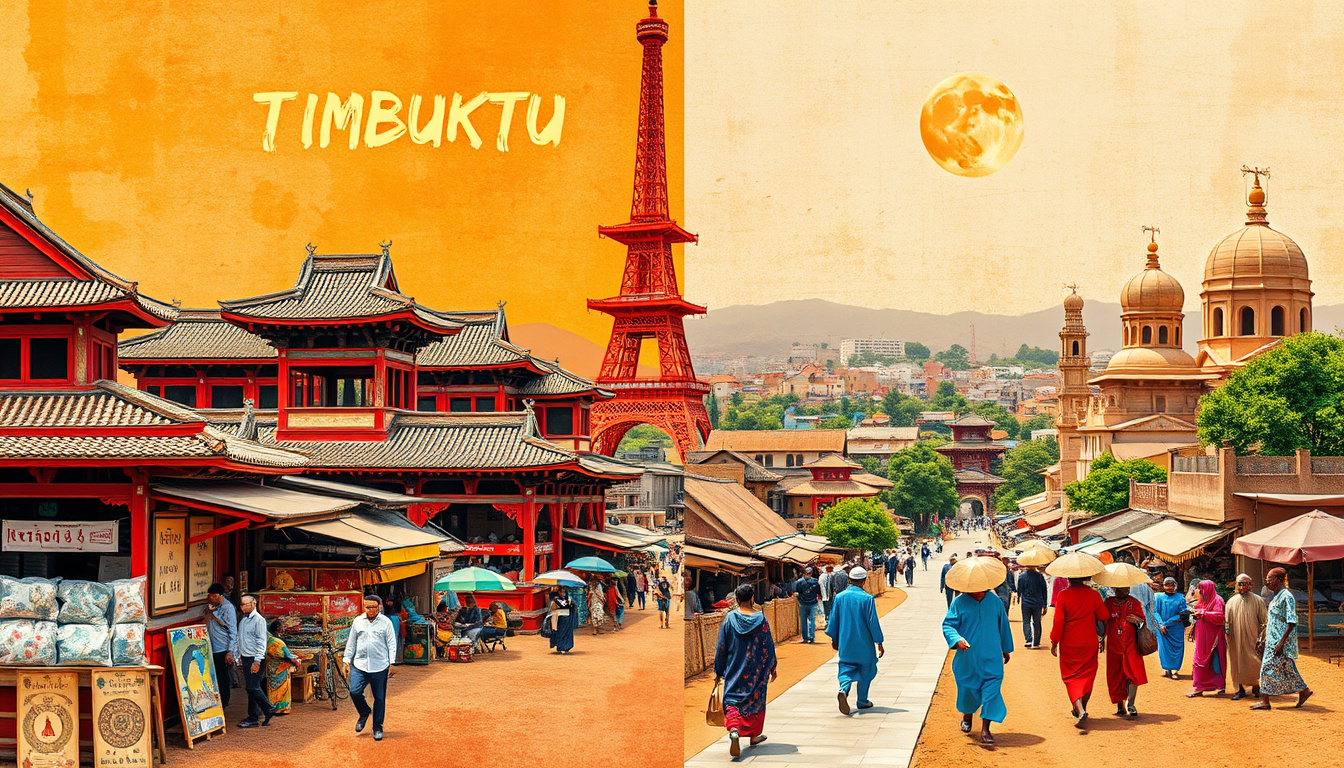In an increasingly globalized world, the interplay between diverse cultures is becoming more pronounced. Among the many fascinating cultural connections that exist, the surprising parallels between Tokyo and Timbuktu are particularly noteworthy. This article, titled ‘Connecting Worlds: Insights from Tokyo to Timbuktu,’ delves into the unique intersections of these two cities, examining their rich histories, modern innovations, artistic expressions, and future collaborative opportunities. By exploring the uncommon threads that link Tokyo, a bustling metropolis in Japan, with Timbuktu, a historic center of learning in Mali, we can gain valuable insights into the ways in which cultural exchange continues to shape our society today.

Key Takeaways
- Tokyo and Timbuktu share unique cultural intersections that highlight common human experiences.
- Historical trade routes significantly influenced the development and cultural richness of both cities.
- Modern innovations in technology are transforming urban landscapes in both Tokyo and Timbuktu.
- Art and literature serve as powerful mediums to connect and express the diverse cultural narratives of these regions.
- Future collaboration between Asia and Africa holds immense potential for cultural exchange and mutual growth.
Cultural Intersections: Exploring the Uncommon Threads of Tokyo and Timbuktu
Cultural intersections are fascinating as they reveal the uncommon threads that connect diverse societies across the globe. This exploration into how Tokyo and Timbuktu serve as symbols of two distinct worlds highlights the rich tapestry of human experience. The bustling metropolis of Tokyo, with its cutting-edge technology, vibrant pop culture, and ancient traditions, contrasts sharply with the historic city of Timbuktu, known for its legendary role in ancient trade routes and as a center of learning and spirituality. By examining the cultural dynamics between these two cities, we can uncover remarkable insights about global interconnectedness. Both cities, while geographically and culturally distant, demonstrate how the essence of humanity is woven through shared themes of resilience, innovation, and the quest for knowledge. The concept of ‘Connecting Worlds: Insights from Tokyo to Timbuktu’ invites readers to appreciate these cultural dialogues, encouraging a more profound understanding of how our shared values transcend borders, ultimately enriching our global society.
Historical Significance: How Trade Shaped These Two Cities
Understanding the historical significance of trade between diverse cities like Tokyo and Timbuktu reveals the interconnectedness of cultures and economies throughout history. Trade has always acted as a powerful catalyst for exchange, enabling cities to flourish by sharing resources and ideas. In this context, Tokyo, with its modern technological innovations and robust economy, stands in stark contrast to the ancient trading hub of Timbuktu, known for its rich history in the trans-Saharan trade routes. Connecting Worlds: Insights from Tokyo to Timbuktu highlights how the flow of goods, such as textiles, spices, and knowledge, has influenced societal development, urbanization, and cultural exchange in both cities. The bustling streets of Tokyo, filled with the latest advancements, represent a new era of commerce, while Timbuktu’s historic manuscripts symbolize the legacy of trade that once connected the East to the West. By examining these two distinct but interconnected cities, we gain valuable insights into how trade has not only shaped their identities but also created enduring bonds between cultures across time and geography.
‘The world is but a canvas to the imagination.’ – Henry David Thoreau

Modern Innovations: Technology and Urban Development in Tokyo and Timbuktu
In the ever-evolving landscape of urban development, the contrasting cities of Tokyo and Timbuktu provide a fascinating study in how technology can reshape environments and connect worlds. Tokyo, often hailed as a beacon of innovation, boasts cutting-edge infrastructure and smart city initiatives that enhance the quality of life for its millions of residents. From advanced transportation systems to sustainable energy solutions, Japan’s capital showcases a seamless integration of modern technology that drives urban efficiency. On the other hand, Timbuktu, with its rich cultural heritage and historical significance, is leveraging technology in unique ways to promote sustainable development and preserve its identity. Initiatives focusing on digital education and eco-tourism are fostering connections that transcend geographic boundaries. By exploring these advancements in both cities, we gain valuable insights into how technology, when applied thoughtfully, can bridge the gap between diverse cultures and create a more interconnected world.
The Role of Art and Literature: Bridging Cultures Through Creative Expression
Art and literature have always played a vital role in connecting worlds, serving as a bridge between diverse cultures and perspectives. From the bustling streets of Tokyo to the ancient city of Timbuktu, creative expression transcends geographical boundaries and fosters understanding among people. Through the vibrant colors of a painting or the evocative words of a poem, artists and writers convey themes that resonate universally, allowing individuals to appreciate the uniqueness of different cultures while finding common ground. Events such as international art festivals and literary exchanges further highlight the importance of art and literature in promoting dialogue and appreciation across cultural divides. By sharing their stories and experiences through various forms of creative expression, artists and authors not only celebrate their heritage but also invite others to join in the exploration of shared humanity. In this way, art and literature truly embody the spirit of connecting worlds, offering insights that enrich our global narrative.

Future Visions: Collaborative Opportunities between Asia and Africa
As globalization continues to reshape the dynamics of international relations, the collaborative opportunities between Asia and Africa become more vital than ever. With the rise of technological advancements and increased investment flows, nations are actively seeking ways to bridge the gap between these two continents. Initiatives ranging from trade agreements to joint ventures in sectors like agriculture and technology showcase how connecting worlds can lead to mutual growth. Particularly, cities like Tokyo and Timbuktu serve as emblematic points, illustrating the potential for cultural exchange, innovation, and economic development. By leveraging these synergies, both continents can create a robust framework for sustainable partnerships, allowing them to thrive in an ever-evolving global landscape.

Leave a Reply